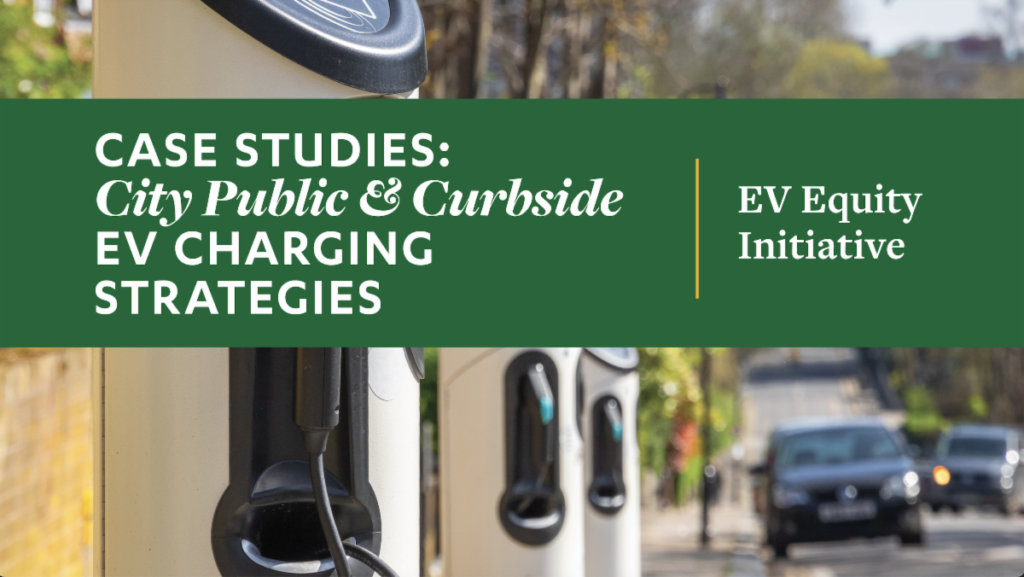How Can Cities Deliver Equitable EV Charging to the Curbside and Public Right of Way?
New CLEE Report Presents Case Studies and Elevates Key Strategies
As California and other states transition to one hundred percent zero-emission new vehicle (ZEV) sales by 2035, local governments will play a crucial role in addressing inequities in the ZEV transition. Limited access to abundant and reliable charging equipment remains a key barrier to ZEV adoption for all, and city governments can lead efforts to broaden charger availability. Specifically, cities can help coordinate stakeholders, streamline permitting processes, and elevate innovative charging models that orient electric vehicle (EV) infrastructure toward equity-centered practices.
Curbside and public right-of-way (PROW) locations are a key venue for city governments to lead EV infrastructure development and deliver a more equitable charging network for residents. These locations may provide particularly useful charging options for residents in underserved communities who are likely to lack access to charging in private driveways or garages, in multifamily dwelling parking lots, or at workplaces. EV infrastructure expansion in these areas can also promote investment in charging near key community facilities and in dense urban environments. Local governments own the PROW and have the ability to shape its use for public mobility – but it is also a highly complex zone that requires innovative and strategic approaches.
Our new case study report, informed by interviews with city leaders and EV charging project directors, gathers insights from city programs that are leading efforts to expand charging infrastructure in the PROW. The case study programs covered in the report span 9 different cities, including Portland, Los Angeles, Seattle, and New York City.
Some key findings include:
- Prioritizing equity can be challenging for strategies based on private Electric Vehicle Supply Equipment (EVSE) providers. By contrast, charging projects led by public agencies can prioritize equity-oriented criteria in key investment decisions, including site selection and infrastructural design.
- Utility leadership is vital to fast-rollout public programs. Whether a city’s grid infrastructure is managed by a municipal- or investor-owned utility company, the utility’s ability to coordinate with public agencies and co-lead the charging program is central to the program’s effectiveness.
- Systematic approaches can yield substantial public benefits. Cities that incorporate EV charging development processes into agencies’ standard procedures and programmatic features can improve efficiency and strengthen the basis for future iterations.
- Residential Level 1 cord cover programs can safely improve accessibility at low cost. The ability to extend a charging cable across the PROW (subject to cord crossing guidelines) can offer residents an affordable charging option that does not require full-scale EVSE installation.
While curbside and PROW charging programs to date represent crucial first steps to develop a comprehensive EV charging network, the findings in this report indicate that cities are only in the early stages of optimizing publicly accessible charging for priority populations. Only a handful of explicitly equity-centered components have reached implementation in the early curbside pilots, with equitable distribution siting frameworks and community consultation processes emerging as early strategies. The report concludes by highlighting several measures that cities can take to further promote equity in EV charging program design and implementation. These additional measures seek to build cities’ decarbonized transit programs around needs assessment, community engagement, pollution reduction and mobility enhancement. Some key recommendations include:
- Prioritize site selection in lower-income and underserved communities.
- Incorporate community input into investment decisions including site selection, mode preference, amenities and design.
- Ensure that priority communities where charging infrastructure will be deployed are also provided with targeted EV incentives and awareness campaigns.
- Enhance mobility through strategies such as car share, mobility hubs, and EV infrastructure co-location with other transportation services.
This policy brief is intended to guide local leaders as they plan and execute public EV charging infrastructure development with a focus on equitable investment. CLEE developed this brief as part of its EV Equity Initiative, which seeks to build locally tailored, community driven, and replicable approaches to the development of electric vehicle and mobility infrastructure in underserved communities in California and the US. This brief is the first in a series of papers that will focus on equitable practices in key areas of EV infrastructure development; future papers will cover shared mobility, EV charging in multifamily housing, and community governance and investment models. The papers will complement a comprehensive Equitable EV Action Plan Framework for local governments that CLEE is co-developing with The Greenlining Institute and Forth.
Access the full report here – Case Studies: City Public & Curbside EV Charging Strategies







Reader Comments